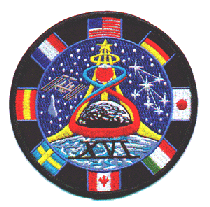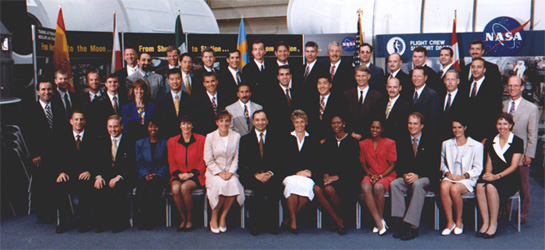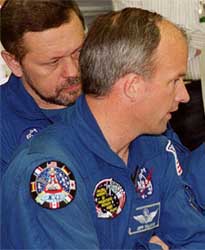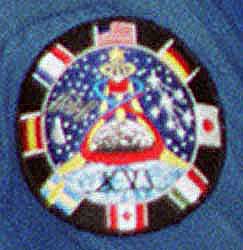

Nine international astronaut candidates joined the 1996 Astronaut Class and also arrived at the Johnson Space Center, Houston, TX,
on August 12, 1996. The international candidates, representing the Canadian,
Japanese, Italian, French, German and European Space Agencies.
"The Class of 1996 continues our international cooperation in space as we move forward into the era of the International Space Station," said Robert L. "Hoot" Gibson, deputy director of Flight Crew Operations. "We welcome the entire class. They have a very exciting time ahead of them."
During their training, the astronaut candidates will receive orientation briefings and tours, as well as numerous scientific and technical briefings, intensive instruction in Shuttle and International Space Station systems, and physiological training and ground school to prepare them for T-38 flight training. Class members also will learn water and wilderness survival techniques.
The People

The 35 American members of the 1996 Astronaut Class are:
David M. Brown, Daniel C. Burbank, Yvonne D. Cagle,
Fernando Caldeiro, Charles J. Camarda, Duane G. Carey, Laurel B. Clark,
Edward M. Fincke, Patrick G. Forrester, Stephen N. Frick,
John B. Herrington, Joan E. Higginbotham, Charles O. Hobaugh,
James M. Kelly, Mark E. Kelly, Scott J. Kelly, Paul S. Lockhart,
Christopher J. Loria, Sandra H. Magnus, Michael J. Massimino,
Richard A. Mastracchio, William C. McCool, Lee M. Morin, Lisa M. Nowak,
Donald R. Pettit, John L. Phillips, Mark L. Polansky, Paul W. Richards,
Piers J. Sellers, Heidemarie M. Stefanyshyn-Piper, Daniel M. Tani,
Rex J. Walheim, Peggy A. Whitson, Jeffrey N. Williams, Stephanie D. Wilson.
The International Candidates are:
Pedro Duque, Christer Fuglesang, Umberto Guidoni, Philippe Perrin and Gerhard Thiele (Europe).
Steve MacLean and Julie Payette (Canada).
Mamoru Mohri and Soichi Noguchi (Japan).
The Artwork
The Astronaut Class of 1996 entered the space program at a unique time in history. News about the possibility of past life on Mars revitalized interest in lunar and Martian exploration. Situated on a field of blue, the International Space Station, the moon and Mars represents the challenging mission in which the graduates hope to participate. The field of 44 stars represents each of the members of the class, the largest in the history of the space program. As a tribute to the Challenger astronauts, seven additional stars from the constellation Volans. This constellation is one of six constellations that the ancient Greeks called Argos Navis, the ship which Jason and the Argonauts sailed in search of the Golden Fleece. The infinity symbol represents the never ending effort of exploration and has the number 96 embedded in it, representing the year in which the class was selected. The streak emanating from the Earth's horizon and stretching through the moon and Mars, culminating in the gold astronaut symbol, is a tribute to the original seven Mercury astronauts. Finaly, the eight flags bordering the patch represents the international composition of the Group XVI Astronaut Class.
Spot the patch !!!


Astronaut Jeffrey Williams (and Boris Morukov) during training for STS-101.